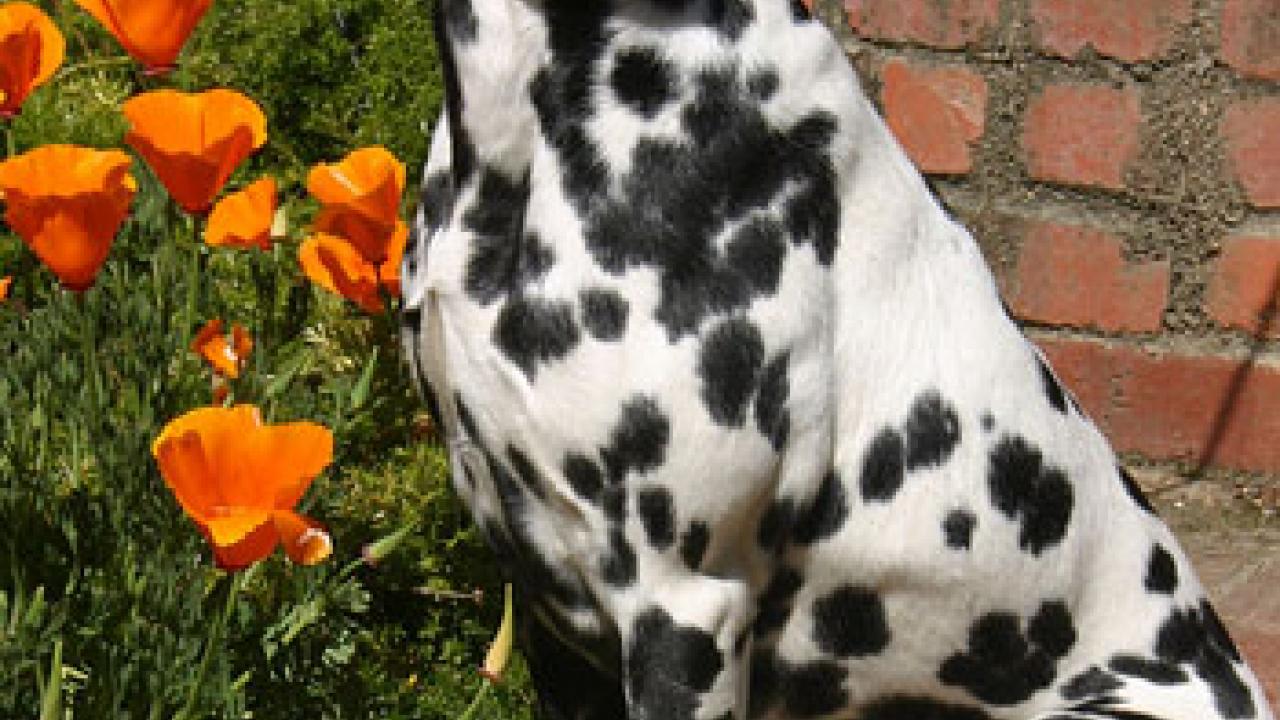A gene mutation that causes high levels of uric acid in all Dalmatian dogs and bladder stones in some Dalmatians, has been identified by a team of researchers in the School of Veterinary Medicine at the University of California, Davis.
The discovery equips dog breeders with the tools to eliminate that trait from the Dalmatian breed and yields clues to the cause of similar problems in humans. The findings were published today (Nov. 7) in the scientific journal Public Library of Science.
"This defect, which in dogs is peculiar to the entire Dalmatian breed, has been reported for nearly a century and was probably unintentionally introduced as breeders worked to select more distinctive spotting patterns," said veterinary geneticist Danika Bannasch, lead author on the study.
"It is now possible that this trait can be removed from the breed by crossing Dalmatians with the normal offspring of the original Dalmatian-pointer breeding that occurred in the early 1970s," she said.
By Dec. 1, the Veterinary Genetics Laboratory in UC Davis' School of Veterinary Medicine will begin offering DNA testing for the mutation in dogs to allow breeders to eliminate the trait. Information on the testing program will be available online at http://www.vgl.ucdavis.edu/.
Background
All mammals excrete waste products in their urine, but only humans, great apes and Dalmatian dogs always produce elevated levels of uric acid in their urine and blood. Other dog breeds do not usually produce uric acid.
In humans, this can result in kidney stones, hypertension and gout, a painful inflammation of the joints. In Dalmatians, high uric acid levels result in the formation of bladder stones that often have to be removed surgically.
Scientists have known since the early 1900s that all Dalmatians have this trait; however, the gene responsible has remained elusive.
The new findings
The researchers collected DNA samples as well as urine samples from hundreds of dogs to identify the gene responsible for high levels of uric acid. Genetic analysis of dogs that are a cross between pointers and Dalmatians revealed that gene to be SLC2A9, a gene that recently has been reported to be important in regulating uric acid levels in humans. DNA analysis showed that mutations in the SLC2A9 gene were responsible for the elevated uric acid in the Dalmatians.
The same mutations also were present in some bulldogs and black Russian terriers, breeds that are not known to be closely related to Dalmatians. This suggests that the gene mutation must be quite old, even predating formation of the Dalmatian breed. Alternatively, the mutation could have been introduced to those breeds by crosses between breeds, the researchers noted.
Because the gene mutation does not always occur in bulldogs and black Russian terriers, breeders can simply use genetic selection to eliminate the unhealthy trait from those breeds. In Dalmatians, however, the mutation occurs in all dogs, forcing breeders to look outside of the breed to correct the problem.
"In recent years, dogs that are about 99 percent Dalmatian and one percent pointer have been bred, successfully eliminating the elevated uric acid trait," said Bannasch. "The result is a healthy dog that that looks like a Dalmatian, maintains the Dalmatian breed characteristics and is genetically almost identical."
She noted that those "backcrossed" dogs, which have been registered as Dalmatians with the United Kennel Club in the United States, offer a valuable resource for correcting the genetic defect that results in the elevated uric acid trait in the Dalmatian breed.
Although humans also carry the SLC2A9 gene, scientists have not yet identified the exact mechanism that causes humans and great apes to have elevated uric acid levels. The recent identification of the responsible gene mutation in dogs will help scientists better understand the related problem in humans.
Collaborating with Bannasch on this study were graduate students Noa Safra and Nili Karmi, staff researcher Amy Young and Professor Emeritus Gerald Ling, all from UC Davis, as well as Robert H. Schaible of Purdue University.
The study was supported, in part, by a fellowship from the Morris Animal Foundation and the National Institute of Diabetes and Digestive and Kidney Diseases within the National Institutes of Health.
Media Resources
Pat Bailey, Research news (emphasis: agricultural and nutritional sciences, and veterinary medicine), 530-219-9640, pjbailey@ucdavis.edu
Danika Bannasch, School of Veterinary Medicine, 530-754-8728, dlbannasch@ucdavis.edu
